Receiving a new tarot deck can be an exciting journey, filled with potential and mystery. To truly connect with and unlock the power of your new tarot deck, start by cleansing and personalizing it. This not only helps solidify your bond but also clears any unwanted energies that may linger from before it came into your possession.
Get to know your cards through simple practices like daily card draws or experimenting with intuitive readings. By handling and shuffling your deck regularly, it becomes a familiar extension of your spiritual practice. Engage with each card, noting the imagery and symbolism that speaks to you personally.
As you delve further, try integrating the deck into your daily routine. Perhaps a morning draw over coffee or tea, or a reflective card session before bed. With time and attention, your tarot deck becomes a trusted companion on your introspective and spiritual journey.
Key Takeaways
- Cleanse and personalize your tarot deck.
- Engage with your cards regularly.
- Integrate tarot into daily life.
Pin it for later! ⤵️
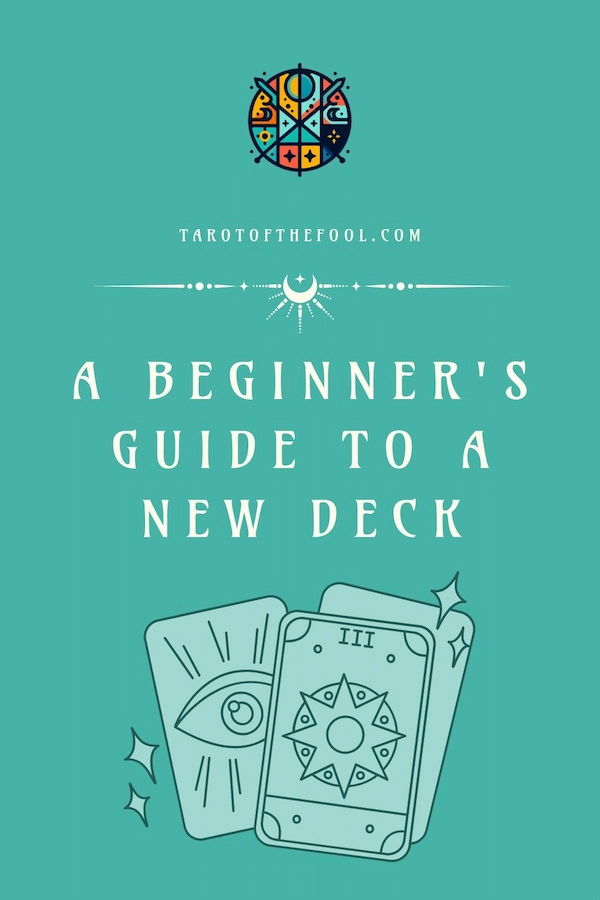
Getting to Know What to do With a New Tarot Deck
When you get your first deck of tarot cards, the best way to start is by exploring the individual cards to understand their overall theme and symbols. It’s a good idea to spend a little bit of time with each card, even doing daily pulls to familiarize yourself with the energy of the deck. This process allows you to build a new connection with your deck, which will improve your first time tarot readings. Approaching a new tarot deck is an exciting journey where you deepen your awareness and build a meaningful bond. This exploration allows you to create a comfortable environment and forge a spiritual connection that enhances your tarot practices.
Ground Yourself, Be Present and Set Your Intentions
Before touching the cards, take a few deep breaths. This helps center your energy. You can:
- Visualize roots growing from your feet into the earth, grounding you.
- Focus on your breathing, releasing any stress with each exhale.
Think about what you want to ask or what you want guidance on. Your intention is the foundation for your reading. It could be a specific question, a theme, or just a general request for insight.
You can say something like:
- “I seek guidance for my highest good.”
- “I am open to receiving clarity on [specific situation].”
- “Please help me understand the energies surrounding me.”
As you lay out the cards for your spread, remain present. Don’t rush. As you place each card, take a moment to connect with its energy before turning it over. Trust that the cards drawn are the ones you need.
Connecting Spiritually
To connect spiritually, consider setting intentions or asking for guidance. This could mean inviting your spirit guides to aid your readings or focusing on your energy and intuition. Feel free to incorporate rituals, such as a simple meditation or affirmations, before you start. Your efforts at this stage build the foundation for a strong relationship with your tarot deck.
If you believe in guides, ancestors, or universal energies, invite them to assist with the reading. You might say a quiet invocation, like:
- “I call on my guides and angels to assist me in this reading.”
- “I ask for wisdom and clarity from the universe.”
This step is about opening yourself to receiving insights. Some people also like to hold their deck and silently ask for guidance.
First Impressions and Creating a Sacred Space
Shuffling a tarot deck is a personal ritual that can vary depending on your style, intuition, or traditions. Before shuffling, it’s helpful to create a calm atmosphere. You might want to light a candle, take a few deep breaths, or meditate briefly to ground yourself. Clearing your mind will help you focus on the reading.
When you first open your new tarot deck, take a moment to absorb your first impressions. Flip through the deck to familiarize yourself with the cards. The visual exploration of cards sets the foundation for your connection with them. Notice the artwork, colors, and emotions that arise. This initial connection can set the tone for your future readings. To honor this process, prepare a sacred space. Choose a quiet corner or room where you feel a sense of peace and clarity.
Setting up your sacred space involves incorporating elements like crystals, candles, or incense. These can help clear negative energies and invite positive vibes. You may also want to include personal items that hold significance for you. This area becomes a sanctuary where you and your deck resonate harmoniously. Feel free to adapt this space over time as your connection with the deck deepens.
Creating a calm, sacred space helps you tune into the energy. You can do this by:
- Lighting candles or incense (sage or palo santo is common for clearing energy).
- Playing soft music or sounds that help you relax.
- Having crystals nearby (like amethyst or clear quartz) if that resonates with you.
- Clearing the energy of the room by setting an intention of peace and clarity. You might say a short prayer, chant, or simply visualize a protective white light around you.
Handling the Cards
Shuffling and handling tarot cards before a spread can be a deeply spiritual and meditative process. It’s all about connecting with the cards, clearing your mind, and tapping into your intuition or spiritual guides.
Handling your cards involves more than just shuffling. Use your dominant hand for a natural, intuitive experience. Begin by gently riffing through the deck to let the cards breathe and release any factory stiffness. Try different shuffling techniques until you find one that feels right.
Cleansing and Clearing Your Deck
Cleansing your new tarot card deck is a good time to remove any residual energy from external sources, especially if it’s a specific deck you bought secondhand. One of the best ways to do this is by passing each card through incense or placing the entire deck under the light of the moon, which ensures the deck’s energy aligns with your own. Cleansing is the first thing you should do before using this magical tool for the first time. When you receive a new tarot deck, it’s important to cleanse and clear it of any negative energy it might have picked up. This ensures a fresh start for more accurate readings with clear intention.
After you start using it, cleanse your deck regularly, especially after intense readings.
Why Cleansing is Essential
Cleansing a tarot deck isn’t just about removing physical dirt but also any lingering energies. A deck may absorb the energy of those who previously handled it, affecting its accuracy. By clearing a deck, you align it with your personal energy and intentions.
Getting rid of these energies is crucial. Without cleansing, you risk getting readings influenced by these unwanted energies, making them unreliable.
Prioritizing cleansing helps enhance your connection with the cards, making your tarot practice more insightful and meaningful.
Cleansing Techniques and Tools
Sun or Moon Cleansing
Cleansing your tarot deck with the energy of the Sun or Moon is a powerful way to reset its vibrations and attune it to your energy. The Sun’s cleansing method infuses your deck with bold, radiant energy, perfect for revitalizing a deck that feels heavy or stagnant. Placing your cards in direct sunlight for a few hours can burn away lingering energies, restoring clarity and strength. However, be mindful that prolonged exposure may fade delicate card designs.
On the other hand, Moon cleansing is a gentler, intuitive process that connects your deck to the cycles of nature. Leaving your cards under the light of a Full Moon enhances their ability to channel emotions, deep wisdom, and subconscious messages. This method is especially useful for decks used in love readings, dream work, or deep introspective questions. Whether you choose the fiery, assertive cleansing of the Sun or the reflective, mystical energy of the Moon, both methods offer a natural, effortless way to recharge your tarot deck for insightful readings.
Smoke Cleansing
Smoke cleansing is a traditional and effective way to clear stagnant energy from your tarot deck, restoring its vibrational purity and deepening your connection to the cards. Using sacred herbs like sage, palo santo, cedar, or lavender, gently pass your deck through the rising smoke with a focused intention – whether it’s to release old energy, invite clarity, or strengthen your bond with the deck. As the smoke curls around the cards, visualize any lingering energy dissipating, leaving your deck refreshed and attuned to your intuition. This method is especially useful after heavy emotional readings or when acquiring a new deck, ensuring that only your energy remains imprinted on the cards. For best results, choose an herb that resonates with your practice and work in a well-ventilated space, honoring the tradition with respect and mindfulness.
Crystals Charging
Charging your tarot deck with crystals is a gentle yet powerful method to cleanse and enhance its energy, aligning it with your intuition and intentions. Crystals like clear quartz amplify clarity and focus, amethyst deepens spiritual insight, and selenite naturally purifies and recharges the deck without needing frequent cleansing. To use this method, place your tarot deck on a crystal slab, in a crystal grid, or surround it with stones overnight to absorb unwanted energy and restore vibrancy. You can also keep a small crystal in your tarot pouch or box to maintain a consistently high vibration between readings. Whether you’re seeking grounding, protection, or intuitive enhancement, crystal charging is an effortless way to keep your tarot deck energetically attuned and ready for powerful insights.
White Light Visualizing
White light visualization is a powerful, intention-based method for cleansing your tarot deck, requiring nothing but your focus and energy. This technique is ideal for those who prefer an intuitive, meditative approach to clearing stagnant energy. To begin, hold your deck in your hands, take a few deep breaths, and visualize a radiant white light surrounding and flowing through the cards. Imagine this light dissolving any lingering or unwanted energy, replacing it with pure, high-vibrational clarity. You can envision the light coming from your own hands, from above, or expanding outward from the deck itself. This method is especially useful for quick resets between readings or when working in spaces where physical cleansing tools like smoke or crystals aren’t available. By infusing your tarot deck with the protective and uplifting energy of white light, you create a strong, personal connection that enhances every reading.
Sound Cleansing
Sound cleansing is a powerful, non-contact method for removing stagnant energy from your tarot deck using vibrational frequencies. This technique works by breaking up and dispersing old energies through sound waves, leaving your deck refreshed and ready for new readings. You can use singing bowls, tuning forks, bells, chimes, or even rhythmic clapping to cleanse your cards. Simply place your deck in front of you and allow the sound vibrations to wash over it, setting the intention to clear away any lingering energy. Some tarot readers prefer to ring a bell over their deck before and after every reading to reset the cards instantly. This method is perfect for those who want a quick, effective, and mess-free way to keep their tarot deck energetically clear while also enhancing their own focus and intuition.
Salt Cleansing (Sea Salt or Himalayan Salt)
Salt has long been used for its powerful ability to absorb negative energy, making it an excellent tool for cleansing your tarot deck. Sea salt or Himalayan salt can help remove lingering vibrations and restore your deck’s energetic balance. To use this method, place your tarot deck in a cloth pouch and set it in a bowl of salt overnight, allowing the salt to draw out stagnant energy. Alternatively, you can place a small dish of salt near your deck to cleanse it more gently without direct contact. Be mindful not to let the salt touch your cards directly, as it can be abrasive and damaging to delicate card surfaces. This method is especially useful for deep energetic resets, particularly after heavy emotional readings or if you’ve acquired a second-hand deck. Salt cleansing is a grounding and effective way to ensure your tarot cards remain clear and attuned to your energy.
Elemental Cleansing: Restoring Balance with Earth, Air, Fire, and Water
Elemental cleansing is a powerful way to refresh your tarot deck by aligning it with the natural forces of Earth, Air, Fire, and Water. Each element carries a unique energy that can help clear and recharge your cards. Earth cleansing involves burying your deck (wrapped in a cloth) in soil overnight to absorb grounding and stabilizing energy. Air cleansing can be done by fanning the cards, placing them in a gentle breeze, or using incense smoke to let stagnant energy drift away. Fire cleansing involves briefly passing your deck over a candle flame, symbolizing purification and transformation – but be mindful to keep a safe distance. Water cleansing can be symbolic, such as placing a bowl of water near your deck, as direct contact with water may damage the cards. By choosing the element that resonates most with you or combining them, you can restore your deck’s clarity and attunement, ensuring accurate and energized readings.
Knocking or Tapping
Knocking or tapping your tarot deck is one of the simplest and most effective ways to clear stagnant energy before or after a reading. This method works by physically disrupting lingering vibrations and resetting the deck’s energy field. To cleanse your cards, hold the deck in one hand and firmly knock three times on the top with your other hand, setting the intention to release any past influences. Alternatively, you can tap the deck against a table or a solid surface to shake off residual energy. Some readers also shuffle the deck immediately after knocking to further refresh it. This method is especially useful when doing back-to-back readings or when you need a quick, no-fuss way to cleanse your deck on the go. Simple yet powerful, knocking or tapping helps maintain a clear, responsive tarot deck, ensuring that every reading starts with fresh energy.
Shuffling with Intention
Shuffling with intention is a natural and effortless way to cleanse your tarot deck while strengthening your connection to the cards. Each time you shuffle, you’re not only mixing the deck physically but also energetically resetting it, clearing away any lingering influences from previous readings. To enhance this process, focus on a cleansing intention as you shuffle – such as “I release old energy and invite clarity” – or visualize white light flowing through your hands into the deck. You can also incorporate deep breaths, affirmations, or a short meditation to reinforce the cleansing effect. This method is particularly useful when you need a quick reset between readings or when working in a space where other cleansing tools aren’t available. By infusing your deck with fresh energy through mindful shuffling, you ensure that each reading begins with a clean slate, allowing for clearer and more accurate insights.
Leaving the Deck in Nature
Placing your tarot deck in nature is a powerful way to cleanse and recharge it with pure, grounding energy. The natural elements help reset your deck’s vibrations, making it feel refreshed and more attuned to your intuition. You can leave your cards under the Full Moon for intuitive renewal, in the sunlight for vibrant energy, or near a tree to absorb stability and wisdom. If you prefer a gentler approach, placing your deck on a windowsill with a view of the sky or surrounding it with flowers, leaves, or crystals can also enhance its connection to nature. Be mindful of the weather – protect your deck from moisture or strong winds by using a cloth pouch or box. This method is especially useful after heavy emotional readings, long periods of non-use, or when you want to reconnect your deck to the grounding and cleansing forces of the natural world.
Covering or Wrapping in Silk or Cloth
Wrapping your tarot deck in silk, cotton, or a natural cloth is a traditional method of both cleansing and protecting its energy. Silk is particularly favored for its ability to shield against outside influences, keeping your deck’s vibrations pure and undisturbed between readings. Natural fabrics like linen or cotton also work well, providing a safe and sacred space for your cards. By wrapping your deck with intention, you create a ritual of care, reinforcing your bond with the cards and ensuring they remain energetically aligned with you. Some tarot readers also store their wrapped deck in a wooden box or place a cleansing crystal like selenite or amethyst inside to maintain a high vibrational state. This method is ideal for long-term storage, travel, or simply maintaining a deck’s energy between sessions, keeping it clear, safe, and ready for intuitive insights.
Regardless of the method, ensure your intentions are clear. With a focused mind, your cleansing process will be more effective, preparing your deck for insightful readings. Always take your time and explore different ways to connect with your new tarot deck, you will feel what resonates the most.
Choose a cleansing method that feels right for you, and that resonates with your tarot practice.
Pin it for later! ⤵️
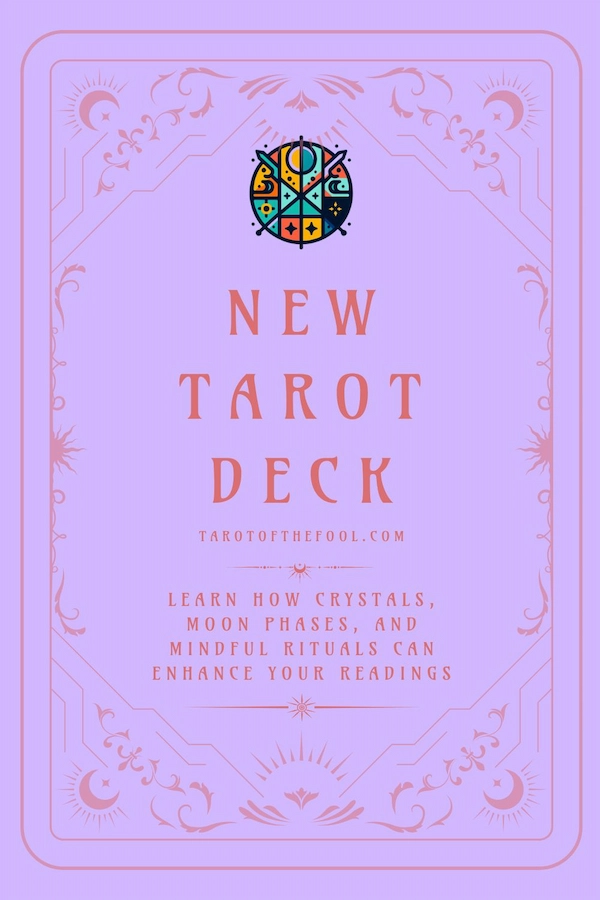
Activating the Deck
To activate your new deck of tarot cards, consider a dedication ritual that aligns your energy with the energy of the deck. A fun exercise involves shuffling while meditating on the deck’s purpose, whether for love readings or general guidance. Draw a specific card like the Queen of Wands or the King of Cups to represent your connection and activate the deck’s full potential. Activating a new tarot deck is essential for connecting with the cards. This allows you to instill positive energy and personal intentions. Key approaches include conducting dedication rituals and personalizing your deck.
Dedication Rituals
Dedication rituals can help you form a bond with the deck. Begin by setting aside some quiet time alone with your cards. Light a candle or some incense to create a calming atmosphere.
As you handle each card, take deep breaths to center yourself. You can also say a short affirmation or prayer. This process focuses the energy and sets your intentions.
Some find it helpful to use sacred smoke like sage or palo santo during the ritual. It’s a way to cleanse the space and infuse the cards with positive energy. Holding the cards to your heart and envisioning light spreading through the deck is another effective technique.
Personalizing Your Deck
Making the deck truly yours enhances your connection with the cards. Start by touching and shuffling them to feel more comfortable. This familiarizes you with the size and texture of the cards.
Consider decorating the box or wrapping your deck in a special cloth. Adding symbols or colors meaningful to you can make a difference.
Some readers keep the deck with special items like crystals. This can charge the cards and maintain their energetic integrity.
Being creative with these personal touches allows the deck to reflect your unique energy and purpose. This personalization is an ongoing process, so feel free to adapt your deck as your relationship evolves.
Understanding Tarot Architecture
When you acquire a new tarot deck, it’s crucial to grasp its structure. This involves recognizing the roles of the Major and Minor Arcana, and understanding the importance of court cards and symbols. Each component plays a pivotal role in tarot readings. The architecture of tarot revolves around the deck of cards, divided into the Major and Minor Arcana, each with a specific order. Understanding this right order helps a tarot reader see the important characteristics and themes of the cards. Whether using the original Rider Waite deck or another, knowing the card faces and their deeper meanings is essential for interpreting the whole thing.
Discovering the Major and Minor Arcana
The Major Arcana consists of 22 cards that represent significant life events and lessons. Each card has its own story and meaning, like The Fool symbolizing new beginnings or The Tower representing unexpected change. These cards are often seen as guiding forces and reflect broader life themes.
The Minor Arcana, on the other hand, includes 56 cards. These are divided into four suits, often associated with the classical elements: Cups (Water), Pentacles (Earth), Swords (Air), and Wands (Fire). Each suit presents everyday challenges and experiences. Understanding the interplay between these suits enriches your readings and adds context to the messages conveyed.
The Significance of Court Cards and Symbols
Court cards in tarot, typically King, Queen, Knight, and Page, signify people, personality traits, or the roles you assume in life. Each card reflects different characteristics or stages in one’s life, such as the Knight of Wands representing passion or energy. Recognizing these traits can offer insights into relationships and personal growth.
Symbols within the cards communicate hidden meanings. Pay attention to elements like animals, celestial bodies, and colors. These may help reveal the meaning of the card beyond its visual imagery. Bold colors often indicate intense feelings, while softer tones may suggest subtle influences. Recognizing these nuances brings depth to your tarot practice.
Pin it for later! ⤵️
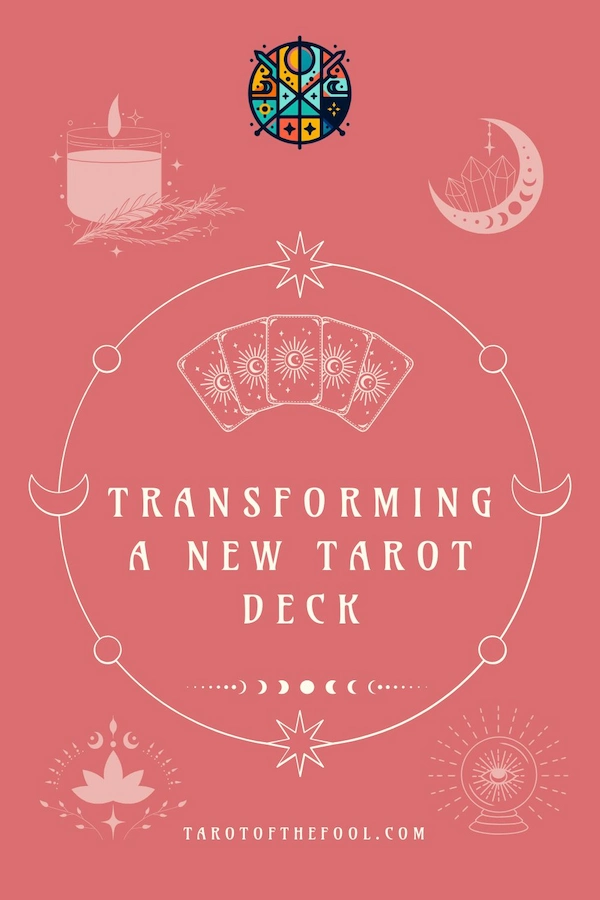
Practicing Your First Reading
As you begin your journey with tarot, it’s essential to keep an open mind and a focused approach. Understanding the basics and starting with simple spreads will build your confidence and foster a deeper connection with your new cards. Your first time doing a tarot reading is a wonderful way to experience the deck’s strengths. A good choice for beginners is to perform simple three-card spreads, which offer insight into the past, present, and potential outcome. Take your time, shuffle with intention, and pull the top card to begin your reading; remember, good readings take practice.
Setting the Right Expectations
Approach your first reading with curiosity rather than rigidity. This isn’t about perfection; it’s a way to explore your intuition and connect with the cards.
Start by finding a quiet space where you can concentrate without distractions. It’s helpful to set an intention or a question you wish to explore through your reading. Remember that it’s perfectly normal not to grasp every card immediately.
Your first reading might feel overwhelming, but this is a chance to grow familiar with your deck. Trust your instincts and prioritize the experience over accuracy. As you practice, interpretation skills will develop naturally.
Simple Spreads for Beginners
When you’re ready to try a tarot spread, begin with a simple three-card spread. This layout is ideal for beginners.
- Past: Draw the first card to reflect on past influences.
- Present: The second card reveals your current situation.
- Future: The third card provides insight into potential outcomes.
These three cards create a manageable framework without complicating your reading. Focus on each card individually, then consider the connections between them.
Over time, experimenting with new ways like a daily single card draw can further hone your skills. This spread introduces you to the rhythm of tarot without overwhelming you, making it a perfect start to your tarot adventure.
Pin it for later! ⤵️
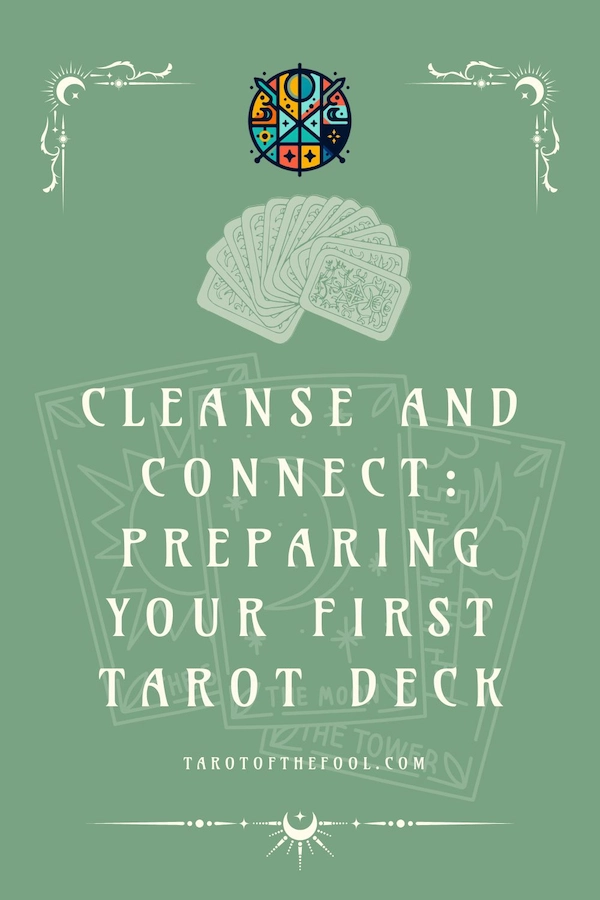
Integrating Tarot into Daily Life
A great way to integrate tarot into your routine is by doing daily pulls of one or two cards to get insights at the end of the day. This practice is especially helpful for tarot readers who want to deepen their intuitive connection with their deck. Over time, you will start noticing patterns that reflect your life’s overall theme. Tarot can be a valuable tool for personal reflection and development. By incorporating activities such as journaling and daily card draws, you can deepen your connection to your tarot deck and foster personal growth.
Tarot Journaling and Daily Card Pulls
Creating a tarot journal enhances your experience with the cards. Start each day with a daily draw, pulling a card to set the tone or reflect on upcoming challenges. Write down your thoughts, interpretations, and feelings about the card. This practice helps you recognize patterns and track your progress over time.
Consider engaging in tarot deck interviews, where you use specific spreads to familiarize yourself further with your deck’s energy. This not only builds a stronger bond with your deck but also enriches your journaling process. Maintaining a continuous dialogue with your tarot cards can transform them into meaningful guides.
Using Tarot for Personal Growth
Tarot can also serve as a catalyst for personal development and reflection. Utilize shadow work to delve deeper into understanding the parts of yourself that you often ignore. By confronting these shadows, you allow for genuine self-improvement.
A daily tarot card can guide introspection and offer insights into your personal journey. Use the cards to explore goals or challenges, offering solutions or new perspectives. Regular practice fosters self-awareness and emotional resilience, making tarot a powerful ally in your self-growth endeavors.
Using tarot for personal growth can be a powerful new tool in your spiritual journey. It helps you reflect on life’s lessons in a different way, and even a new person can use tarot to gain insights. Over years of experience, you’ll start noticing deeper patterns and meanings from each reading, without needing any external sources.
Enhancing Your Tarot Experience
To elevate your tarot journey, consider integrating elements such as crystals and lunar cycles. Exploring a range of tarot and oracle decks can also enrich your readings. You can enhance your experience by experimenting with different methods of shuffling, such as the overhand shuffle, and using tarot bags to store the cards. Using different decks for various kinds of readings, or paying attention to specific characteristics like the use of color and size of the cards, can give you a deeper connection to the card meanings and potential outcome.
Incorporating Crystals and Moon Phases
Crystals can amplify the energy of your tarot deck. Creating a crystal grid around your cards can enhance their potency. For example, use amethyst for intuition or clear quartz for clarity.
Explore how moon phases, like the full moon, affect your readings. Cleansing your deck under moonlight can recharge its energy. Pair specific phases with different intentions. The new moon is ideal for setting fresh goals, while the full moon supports completion and insight.
By syncing with lunar cycles and utilizing the power of crystals, your readings can grow more profound and meaningful.
Exploring Different Tarot Decks and Oracle Cards
There are different kinds of readings, and each type may require a different way of shuffling or interpretation. Tarot cards, like the original Rider Waite deck, and oracle cards offer various approaches to divination. As you explore different decks, keep in mind that choosing the right one is about personal preference, whether it’s the card’s faces, symbolism, or themes.
Experimenting with different tarot decks can offer new perspectives and insights. Each deck has its own symbolism and art style, influencing your interpretations.
Consider incorporating oracle decks into your practice. While tarot follows a structured format, oracle decks provide more freedom in readings. They often focus on personal growth and spiritual guidance.
Switching between decks and combining tarot with oracle cards can refresh your approach and deepen your connection to the cards. This variety keeps your practice dynamic and engaging.
Get Our Tarot Monthly Card Tracker
Keep a detailed record of your Tarot readings with our Tarot Monthly Card Tracker, designed to help you spot patterns and deepen your intuition!
Pin it for later! ⤵️
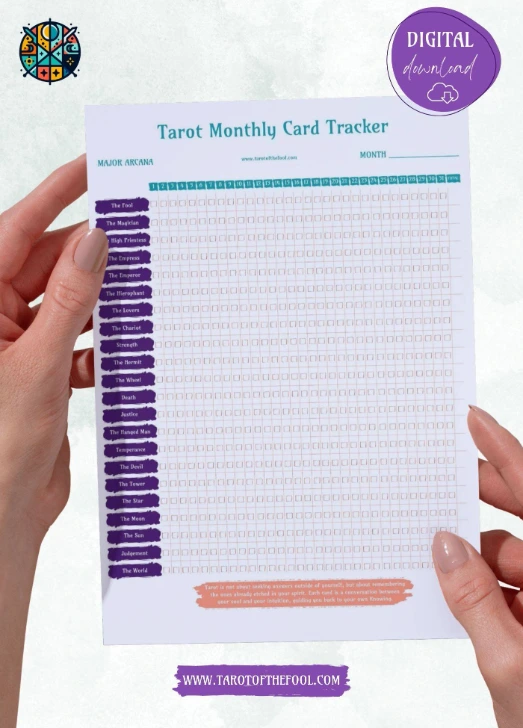
What Will You Get?
- Monthly Tarot Card Tracker – Perfect for tracking your daily pulls and spotting recurring themes.
- Separate Pages for Major & Minor Arcana – Keep your readings organized with dedicated tracking sheets for both the Major Arcana and Minor Arcana.
- Beautiful & Functional Layout – Easy-to-use design for both beginners and experienced readers.
- Printable & Digital-Friendly – Print and add to your Tarot Journal, or use digitally with your favorite notetaking app!
Improve your Tarot practice with this beautifully designed Tarot Monthly Card Tracker! Whether you’re looking to uncover patterns in your readings or deepen your connection with the cards, this tracker makes it easy to document and reflect on your journey.

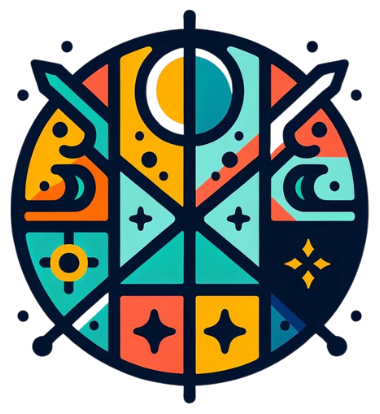

No responses yet